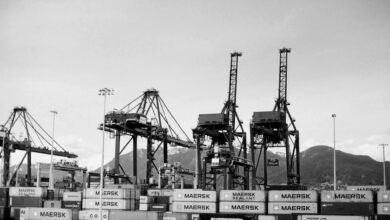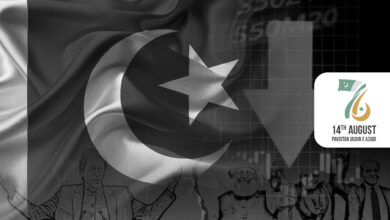International trade allows countries around the world to specialize in goods and services that they are relatively good at producing. With the advancement in transportation and information technology, this exchange has become much easier. This article describes the benefits of trade, world trading system and Pakistan’s standing when it comes to trade.
Benefits of Trade
1.An Engine for Growth
Countries trading extensively are on average more efficient at producing goods and services. This is simply due to the nature of trade itself. By eliminating the need to produce everything at home, trade channels productive resources towards goods and services that a country is relatively better at producing. In principle, if all countries do this, it raises the amount of goods and services available throughout the world. This increased efficiency directly feeds into higher economic growth for countries that trade more.
Trade also contributes towards higher growth by accelerating the speed of technological progress. When goods cross borders, so do people and ideas. Trade also induces innovation by increasing the competition. Existing research has shown how increase in trade directly leads to more innovation that kick starts a positive feedback loop.
Global relation of Exports and GDP per Capita
Export intensity is positively related with high GDP per capita around the world
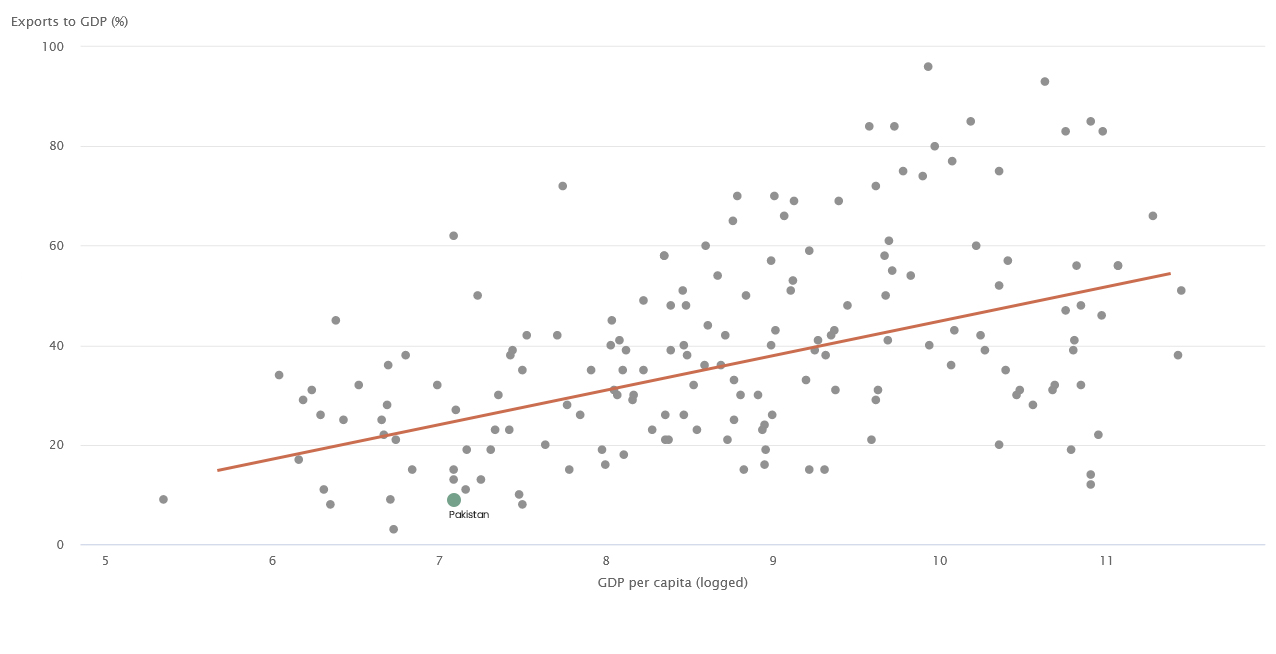
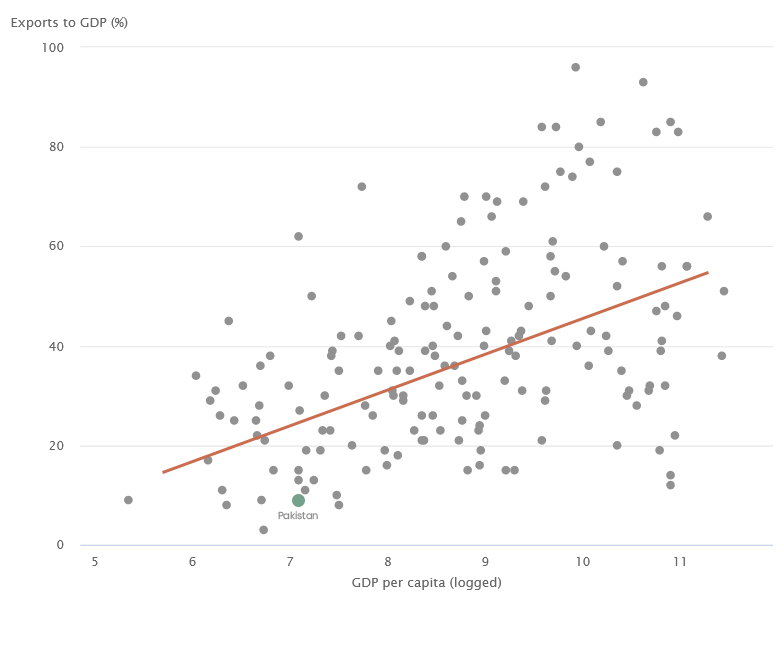
Source: World Bank
2.Increasing Variety
While the efficiency channel would explain trade between countries better at producing different goods, we do see in the data that similar countries trade even more extensively than others. This observation was the foundation of the New Trade Theory. Simply put, even countries that are alike in terms of technology and endowments of the factors of production gain from international trade as they get more varieties of the same goods. Countries produce goods more efficiently when they produce in large quantities (called the economies of scale) which makes specializing in particular varieties better for the producers as well as the consumers.
The ‘love for variety’ is the reason why we do not have just one type of biscuits on aisles of grocery stores and just one type of lentils cultivated all over the country. Trade increases welfare by providing more varieties that would not have been produced in a single country or region.
3.Risk Mitigation
Another benefit of international trade comes in the form of diversifying sourcing and product markets. Trade enables firms to be less reliant on domestic suppliers and markets (for their inputs and products), both of which are subject to country-specific adverse events.
A very recent example of this came in mid-2020 during the COVID19 pandemic. While it is a global phenomenon, it has not affected all countries simultaneously. Since China was able to contain the virus by March, it revamped the production of much-needed Personal Protective Equipment and other medical devices. Trade allowed consumption of these essential products all over the world even when production was disrupted in many countries.
World Trading System
Let us now briefly visit the mechanism and policy objectives of the world trade system in the 20th and early 21st century.
1.Mercantilism of the Early 20th Century
The first half of 20th century was marred by highly restrictive trade policies due to massive wars, economic downturns and political distrust. Countries around the world resorted to trade protectionist measures to boost their own production. One of these measures widely used was import tariffs (a tax on foreign products). This tax raises the price of imported items discouraging their consumption. The promotion of exports and restriction of imports to boost trade balance is also called Mercantilism. However, as it turned out, if everyone is protectionist, everyone loses. The world soon realized this, which gave rise to multilateral global trade institutions.
2.GATT/WTO era
In 1948, the General Agreement on Tariffs and Trade (GATT) took effect. It was first of its kind multilateral agreement on trade that initially had only 23 signatories, Pakistan being one of the founding members (it now has 164 member countries). GATT was designed to have future rounds of negotiations to liberalize trade both in terms of depth (deeper tariff cuts) and breadth (coverage across more products). The Uruguay Round in 1994 led to the graduation of GATT into World Trade Organization (WTO) in 1995 (henceforth I will use WTO to denote GATT/WTO).
The WTO has been a strong pillar of rules-based global trading system that is predicated on the ideals of reciprocity in concessions and non-discrimination in trade policies. Two of the most influential of the WTO’s contributions are the (i) Most Favored Nation (MFN) rule, and (ii) dispute settlement mechanism.
The MFN rule requires members of the WTO to extend a tariff concession to all the members if it is extended to any country. This ensures non-discrimination and reliability. At the same time, the WTO established a dispute settlement mechanism to ensure that deviations from trade rules are addressed through an unbiased process. These pillars, among others, have played a substantial role in creating a healthy trading environment that spurred a new era of globalization.
WTO has been immensely successful in expanding international trade. In the first 50 years, trade increased by around 20 times and trade was growing 3 times as fast as the output. This was achieved through reduction in average world tariff rate from 22% in 1947 to less than 5% more recently.
3.Recent Emergence of Global Value Chains
After the formation of WTO, the world has also seen a sharp and persistent rise in the bilateral and multilateral Trade Agreements. Despite having the non-discriminatory MFN clause, the WTO rules also allow members to have trade agreement which may undercut the MFN tariff rates. This has allowed regional trading partners to form Regional Trade Agreements (RTA) with essentially zero import tariffs and lower non-tariff barriers (such as product standardization). Such RTAs also encouraged fragmentation of production across borders giving rise to the Global Value Chains (GVC).
To visualize GVCs, consider a car plant in country B that performs 3 operations of installing engine, hood and wheels to make a car. With very high import tariffs on cars and car parts, these parts would usually be bought domestically and assembled in the country in which they are to be sold. Now suppose country B signs an agreement with country A where wheels are cheaper than B. Plants in B would now import wheels from A and produce cars for B. Further suppose that A and B add country C to the trade agreement that lowers its import tariffs for cars. This could result in cars made in country B being exported to country C. This is the idea of GVCs where the exports of a country do not have to be completely manufactured domestically i.e. exports contain foreign ‘value-added’. Needless to say, in the above example the wheels manufactured in country A may have their own cross-border value chain.
Pakistan’s Performance
Regional comparison of Exports to GDP
Pakistan’s exports have declined steadily since 1990s
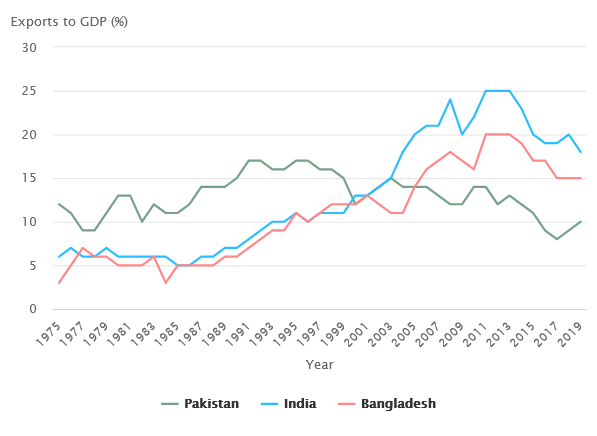
Source: World Bank
Let us now shift gears towards Pakistan stands in terms of trade performance. In a nutshell, Pakistan has a declining exports-GDP ratio, less diversified export basket, and stagnant imports-GDP ratio. The exchange rate policy has played a role in this but let us delay that discussion for now.
While Pakistan had a high exports-GDP ratio during late 1970’s compared to India and Bangladesh, it has remained constant and has even started to decline since 2000. Other countries in the region have had a rally in this area with India and Bangladesh showing strong export performance since late 1980s.
On the composition side, Pakistan’s reliance on exports has been concentrated in a few (and the same) industries in the past 20 years. Textiles remain the dominant exporting industry, from 70% export value in 2001 to 55% in 2018. Among textiles, House linens remain leading product in past 20 years followed by non-retail pure cotton yarn. While showing lack of movement towards more value-added industries, it points to an additional problem of low diversification in the export bundle which makes it susceptible to demand or supply ‘shocks’.
Pakistan’s trade composition by sector
While a bulk of exports still take place in textiles, import intensity has shifted away from Machines.
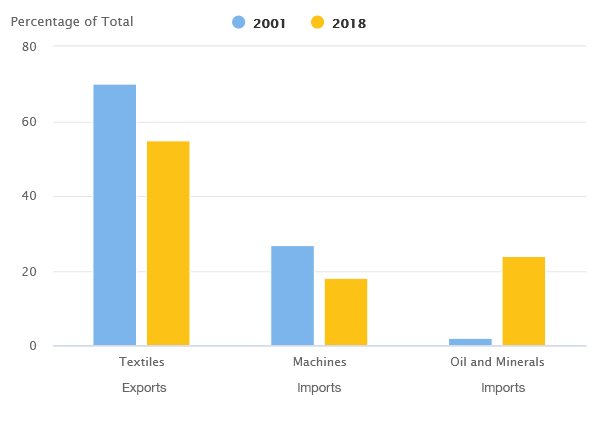
Source: Observatory of Economic Complexity
On the other hand, Pakistan’s import composition has moved towards inflexible petroleum imports. The most intensively imported product changed from being machinery and equipment (26.5%) in 2001 to being Minerals and Petroleum (23%) in 2017. While Petroleum could be used as an input, it is also a final consumer good. This has wide-ranging consequences, from low productivity (from not importing direct inputs) to inflationary pressure from devaluations (since devaluations cannot reduce imports of less price-sensitive goods).
Moreover, Pakistan’s imports-GDP ratio has been stagnant. Why is that a problem? Multiple studies have shown how imports facilitate exports by providing necessary and high-quality inputs, allowing technology transfers, and promoting Foreign Direct Investments (FDI) into the country. As mentioned earlier, countries participating in GVCs (and hence growing faster) also import more. Following figure shows how the relationship between exports and imports have become closer to 1-to-1 more recently.
Global relation of Exports and Imports
Correlation between Exports and Import intensities of countries begin to rise as participation in GVCs rises
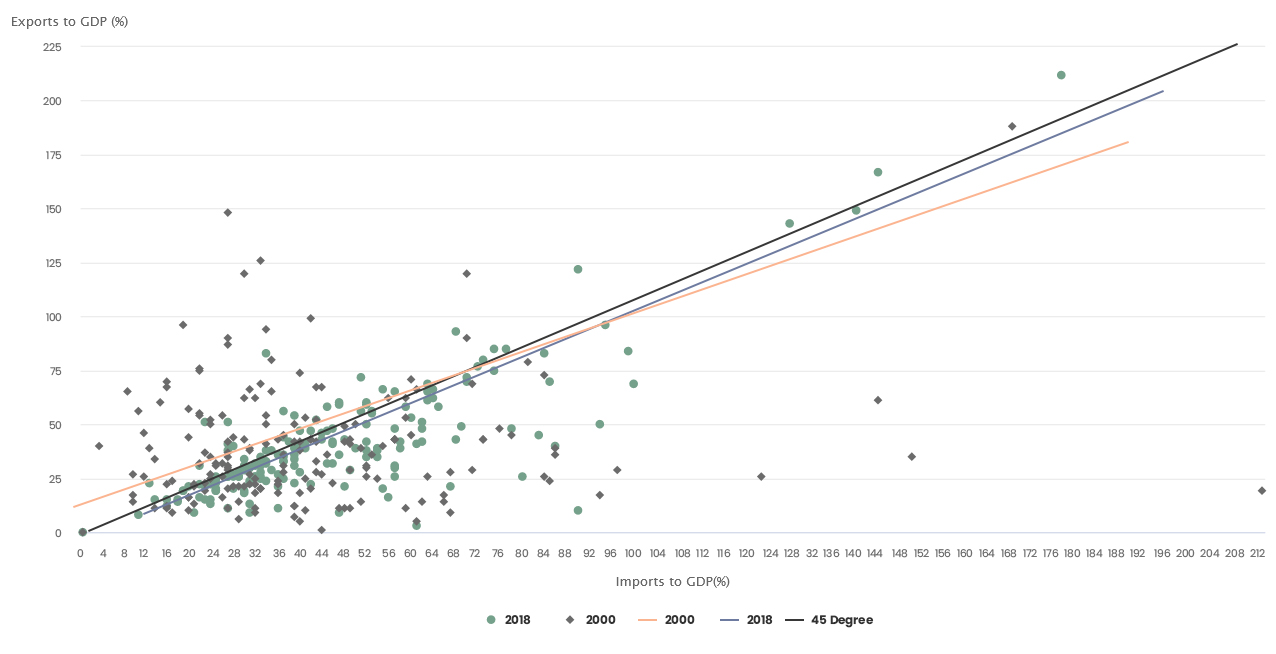
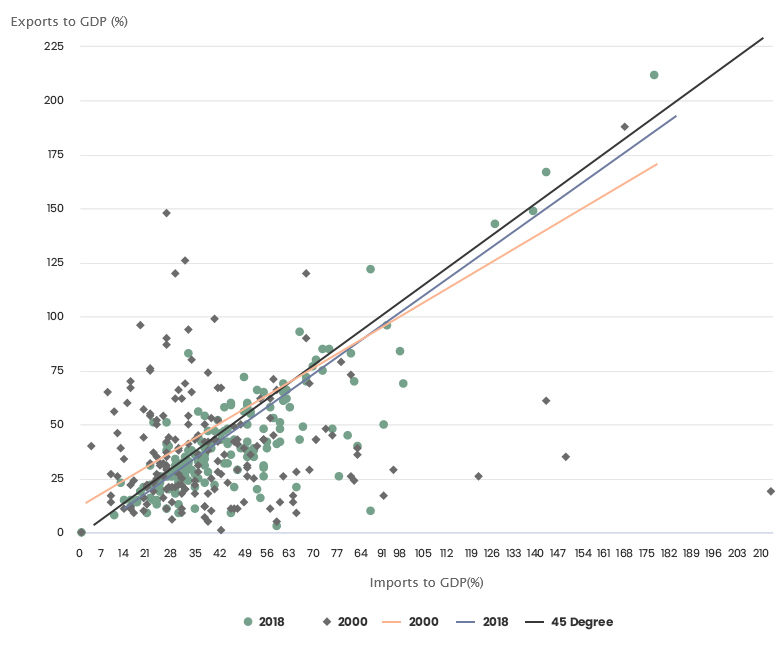
Source: World Bank
Regional comparison of Imports to GDP
Pakistan’s imports have been stagnant in past 4 decades
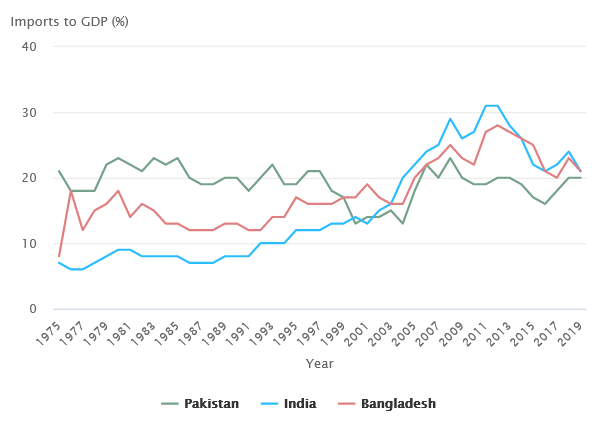
Source: World Bank
Another cause for concern about stagnant imports is its impact on FDI. Domestic affiliates of foreign firms are known to source their inputs from their country of origin. Making importing easier and reliable would encourage FDI by ensuring foreign investors their supply of desired inputs. On a bigger level, FDI would lead to technological growth that feeds into exports. Vietnam is a good example of how higher imports are correlated with higher exports and growth.
Vietnam Export and Import intensity
Vietnam’s exports and imports grew at the same time with import intensity often being higher.
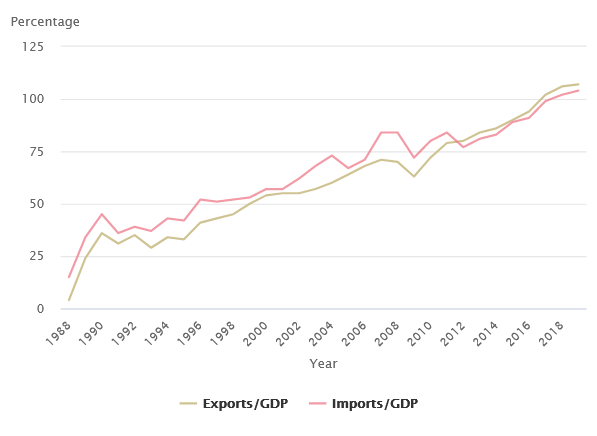
Source: World Bank
To sum up, we all trade multiple times a day to enjoy goods and services that others are relatively good at producing. Without trade we would need to grow our food, weave our clothes and produce our own TV shows. At the international level, all the benefits of trade multiply. International trade of ideas and goods allows mobile phones designed in California and produced in China using inputs sourced from Chile to be consumed in Pakistan. While Pakistan so far has not kept up with the fast-paced globalization, policies that aim to increase Pakistan’s participation in GVCs are likely to turn the situation around.
The article is written in the author’s personal capacity and the findings and opinions expressed here do not necessarily reflect the views of the World Bank.

